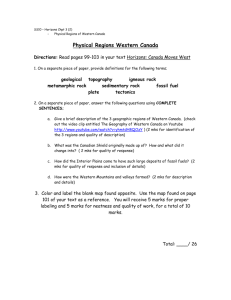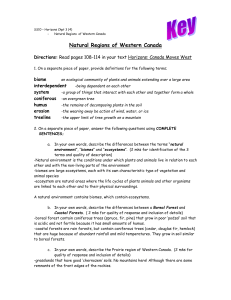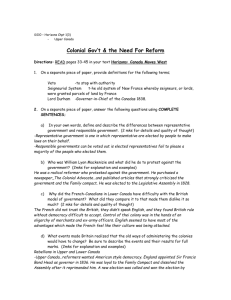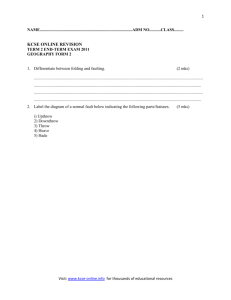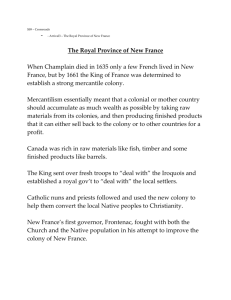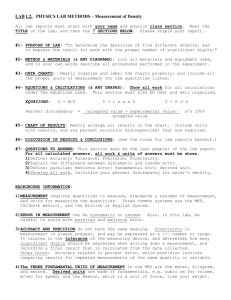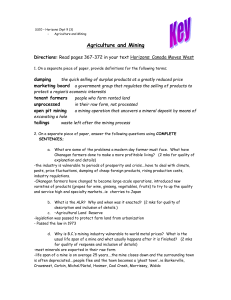introduction to computers
advertisement
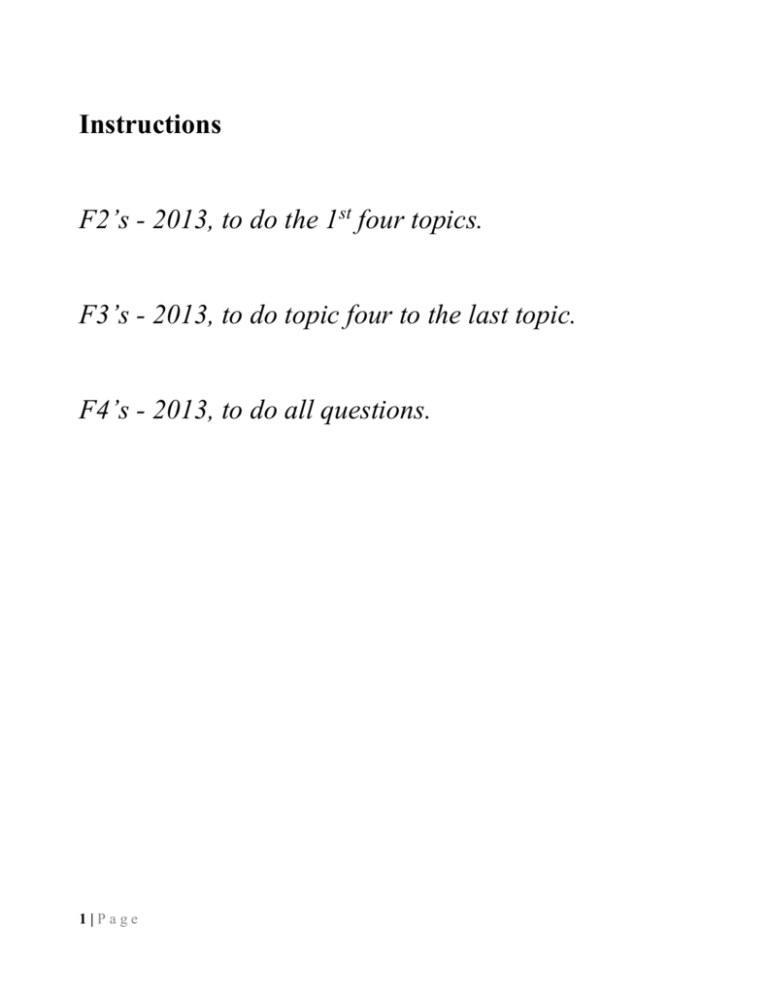
Instructions F2’s - 2013, to do the 1st four topics. F3’s - 2013, to do topic four to the last topic. F4’s - 2013, to do all questions. 1|Page INTRODUCTION TO COMPUTERS 1. (a) Clearly define a computer (b) Give one reason why a computer is referred to as an electronic device 2. Explain the following terms as used in computer science (i) Data (ii) Program (iii) Data processing (iv) Information 3. State any three functions of a computer 4. Explain the following input/ output terms as used in computer systems. Give an example for each (a) Read - (b) Write - 5. State different parts that make up a computer 6. (a) Explain the term system Unit (b) List four devices located under the cover of the system unit (c) Give two differences between tower – style and desktop system units 7. Computers have evolved through a number of generations. List any 4 characteristics of the first generation of computers. 2|Page 8. Briefly explain the classification of computer according to historical development (generations) 9. State four factors used to classify computers 10. State the differences between desktop computers and laptop computers 11. (a) Explain the emerging trends in microcomputer technology in relation to size (b) Give two reasons why smaller computers like Laptops tend to be more expensive than Desktop computers 12. Which category of computers would you place an N- series Nokia phone 13. Give three reasons why a mobile phone is regarded to be a computer 14. (a) Mention three Analogue devices (b) Give three example of special – purpose computers 15. State a specific example where each of the following types of computers can be used (a) Supercomputer (b) Mainframe computer (c) Minicomputer (d) Microcomputer / personal computer 16. (a) Define a microcomputer (b) Differentiate between a microcomputer and a personal computer (c) List three factors to be considered when purchasing a microcomputer 17. Explain four reasons which make microcomputers suitable for personal computing work 18. (a) Identify and explain five areas where computers are used to process data. 19. Identify three advantages of using computers in banking 3|Page 20. (a) Define the term ‘ computer laboratory’ (b) Give two factors to be considered when preparing a computer laboratory 21. List down three safety precautions one should observe when entering a computer laboratory 22. Describe the ideal environment for a computer to work properly 23. Explain why smoke and Dust particles are harmful to a computer 24. Identify three facilities that will ensure proper ventilation in a room 25. Why must foods and beverages be kept out of the computer room? 26. Why would it not be good to install Powder or Water – based fire extinguishers in the (3 mks) computer room? 27. (a) State one reason why a computer needs to be connected to a stable power supply (b) List down four functions of the uninterruptible Power Supply (UPS) (4 mks) 28. Mention two things that are likely to cause strain- in the computer room 29. Identify three proper sitting postures while using the computer 30. State two methods of minimizing dust in a computer laboratory 31. Name two main causes of fire in the computer laboratory and give the precautions that should be taken to guard against them 32. What is the purpose of labeling a diskette? 33. List three things that can spoil a printer if they are not of the correct specification, and explain what damage may be caused. 34. Explain three ways that computer technology could make office more efficient 35. (a) Explain the steps you would follow to set up a new computer 4|Page (3 mks) (b) Outline three reasons why it is important to first shut down the computer before turning it off 36. A computer must go through the process of booting/ initialization before use (a) Briefly explain the term “computer booting”. (b) Explain what happens in the computer during the booting process. (c) Give and explain two types of booting (d) What type of memory is used to store the boot up program (the first program to be executed on switching on a computer? 37. (a) What is a computer keyboard (b) List four types of keys found on a computer keyboard, giving an example of each (c) Name the keyboard keys that will help you: (i) Type the upper character in a key - (ii) Execute a selected command - 5|Page (2 mks) COMPUTER SYSTEMS 1. Define the following terms as used in computing (i) System (ii) Computer system 2. Differentiate between a computer and a computer system 3. (a) List and explain three functional elements of a computer system ( 6 mks) (b) Draw a well – labeled diagram showing the functional units of computer hardware 4. (a) Give two main functions of a computer input device. (2 marks) (b) Give an example of a: (3 marks) (i). Device that reads data (scanning device). (ii). Keying device. OH). Pointing device. (h). Voice input device. (v). Printing device. 5. State two advantages of using a mouse instead of a keyboard. (2 marks) 6. Outline any two advantages of a light pen as an input device, (2 marks) 7. (a) What are computer scanning devices? (2 marks) (b) Name the type of scanner used: (2 marks) 8. Mr. Otieno a French teacher used speech method to store students oral answers to an exam into a computer (a) What is a speech input? (b) State two advantages and two disadvantages of using this method of data input (4 mks) 6|Page (c) State four areas where speech input would be used 9. Name two examples of scanning (data capture) devices used at point of scale terminals in supermarkets 10. (a) What are turnaround documents (b) Name any two data capture techniques that make use of turnaround documents 11. List five factors one would consider when selecting a data input device (4 mks) 12. Describe three functions performed by the CPU ( 3 mks) 13. Explain the functions performed by each of the following central processing unit elements 14. (i) Control Unit (ii) Arithmetic and logic Unit (iii) Registers (iv) The main memory (v) The system clock ( 2 mks) In reference to ALU, explain the meaning of logic operations and give an example of this processing operation 15. Give four types of registers found in the CPU 16. (a) Name the basic unit used to measure the processing speed of a computer ( 1 mk) (b) A computer processor speed is measured in Hertz. What fraction of a second is the following? 7|Page 17. 18. (i) 1. Nanosecond (ii) 1. Microsecond (a) What is a computer bus? ( 1 mk) (b) ( 3 mks) State the functions of each of the following computer bus (a) What is the computer Motherboard? (b) State any four components found on the computer motherboard 19. (a) What is a Drive? (b) State any two types of computer drives, giving an example of a storage device used by each 20. ( 3 mks) (a) Give two reasons why there are many forms of computer storage devices ( 2 mks) (b) State three different examples of auxiliary storage devices 22. 21. Using examples, distinguished between: (i) Primary and secondary (ii) Fixed and removable disks Explain the following storage devices (i) Hard disk (ii) Flash disk (iii) Zip disk 8|Page (2 mks) 23. (a) Compare a floppy disk and zip disk in relation to size (b) 24. ( 2 mks) Give three disadvantages of floppy disks as storage devices (a) State three advantages of using hard disks as medium of storage (b) Describe three precautions you would take to avoid damaging the hard disk (c) 25. ( 3mks) Describe the structure of a hard disk in reference to cylinders, tracks and sectors State two reasons why Magnetic tapes are not commonly used as computer data storage medium today 26. Differentiate between: (i) Microcomputer and microprocessor (ii) Volatile memory and non- volatile memory (iii) RAM and ROM (iv) Hard disk and floppy disk (v) Magnetic and optical storage media (vi) Hardcopy and softcopy output (vii) MICR and OCR scanners 27. Explain four rules for handling magnetic disks 28. (a) Calculate the capacity in MB of a two sided floppy disk with 6 sectors per surface, and 512 bytes per sectors (b) A double – sided disk contains 40 tracks on each side. The tracks are divided into 9 sectors of 512 bytes each. What is the total capacity of the disk in megabytes? 29. ( 2mks) By giving examples, differentiate between primary and Secondary Computer storage ( 3 mks) 9|Page 30. (a) State four functions of Read – Only Memory (ROM) (b) Give three characteristics of ROM (c) Name two different types of ROM 31. (a) Outline three characteristics of Random Access Memory (RAM) (b) Name the two types of RAM clearly starting their differences (3 mks) 32. The diagram below shows as example of a secondary (i) Identify the name of the devices (ii) List down two advantages of this device over a floppy disk in storage ( 2 mks) 33. (a) List any four examples of optical storage devices (b) Give two advantages of a digital Versatile Disk over a normal Compact disk 34. (a) State the two types/ forms of computer output (b) List any four examples of output devices in a computer (c) 35. Identify three Functions of computer devices (a) State one function of the screen (monitor) 10 | P a g e (b) Show two differences between a CRT monitor and a flat- panel display (c) Give there examples of flat- panel monitors available in the market today 36. (a) What are pixels? (b) What role do pixels play in screen display? (c) Give two advantages of the higher number of pixels per square centimeter (2 mks) 37. (a) What are character printers? (1 mk) (b) Give two examples of character printers 38. Distinguish between impact and non impact printers and give two examples of each 39. (a) Distinguish between a line printer and a page printer (b) State three advantages and one disadvantages of: (i) Laser Printers (ii) Inkjet Printers 40. Highlight four factors one should consider when purchasing a printer (4 mks) 41. List three advantages of a plotter over normal printer machines 42. Give two advantages of using sound output devices 43. George connected new multimedia speakers to his computer and tried to play his favorite music CD, but no sound came out. Suggest two problems that might have occurred ( 2 mks) 44. List down 4 factors to consider when buying an output device 45. Define the following terms (a) Port (b) Data interface cable (c) Power cable 11 | P a g e 46. State the function of the power supply unit found in the system unit (1 mk) 47. (a) Name any two peripheral devices which get their power supply through ports (b) State the type of port that would commonly be used to connect the following devices (i) 48. Mouse (ii) Modem (iii) External CD drive (a) Explain two differences between serial and parallel communication ports of a computer (b) Give two major advantages of a USB interface cable over other cables in the computer 49. Outline three precautions one should take when assembling a computer 50. State six factors which you would consider when selecting computer hardware for an organization 51. 52. List down any four hardware components you can add or upgrade in a computer system (a) What is warranty with reference to the purchase of computers (b) Why is it important to carefully study a warranty before committing yourself by signing it? (c) List down three issues to understand about warrants 53. What are clones with reference to computers and what is their disadvantage? 54. (a) What is standard software? (b) Small and large scale organizers are turning to the use of in- house developed software for the processing activities rather than use of standard software (i) What is in- house developed software? (ii) Give two reasons that may be influencing these organizations for such a decision 55. Differentiate between single- purpose programs and integrated software 56. Explain the following considerations when purchasing software (i) Authenticity (ii) Portability 12 | P a g e ( 2 mks) 57. Differentiate between portability with reference to hardware and software 58. (a) Explain why documentation is necessary for any software package (b) A firm intends to purchase new software. List three items of documentation that should accompany the software 13 | P a g e OPERATING SYSTEMS 1. The central processor and peripheral devices of a computer system are coordinated by the operating system (a) Define the term ‘operating system’ (b) List two resources/ components that an operating system manages (c) There are several types of operating systems in use today. State two examples of Operating systems which you are familiar ( 2 mks) 2. Name the two latest operating systems from Microsoft corporation ( 2 mks) 3. Explain any four functions of an operating system software ( 8 mks) 4. What is an interrupt? 5. Give three ways in which operating system are classified 6. Giving an example in each case, explain the following types of operating systems (a) Single – user / single tasking (b) Multi- User/ Multi- tasking 7. ( 3 mks) A computer user may interact with a computer either through Graphical User Interface (GUI) or though typed commands (a) Give one advantage of using GUI based operating system over a command line interface ( 1 mk) (b) Some computer systems still use command line interfaces. State two advantages of command line interface 8. What is a deadlock in reference to operating systems? 9. Explain briefly the following concepts as used in the windows environment: (a) 14 | P a g e Desktop (b) Window (c) Icon (d) Sidekick menu (e) Taskbar (f) Task 10. Identify three functions of taskbar 11. State two differences between Disk Operating System (DOS) and Windows operating system 12. ( 2 mks) Identify three factors you would consider when choosing an operating system for use in a computer ( 3 mks) 13. Explain how windows organizes information in reference to files and folders 14. (a) Distinguish between systems files and application files ( 2 mks) (b) State the extensions used signifying the following file types (2 mks) 15. (a) List and explain down the three parts of the windows Taskbar ( 3 mks) (b) Outline the procedure of renaming a file or folder using windows operating system (3 mks) 16. (a) What is a dialog box? (b) List five settings that may be found in a dialog box 17. (a) Define ‘ folder/ directive tree’ (b) Give two examples of root directories you know 15 | P a g e (1 mk) (c) Give three uses of sub- directories or subfolders 18. (3 mks) (a) (i) Explain the meaning of backup ( 2 mks) (ii) Explain two methods you can use in windows to back up data into a storage device (b) Identify two reasons why a user needs to know the space available for data storage in the hard disk 19. Name the command one would use to repair cross- linked files in graphical user interface software 20. ( 1mk) (a) Explain the team Disk Defragmenter, and give two advantages of this feature ( 3 mks) (b) Distinguish between disk compressing and disk defragmenting 22. Give two reasons why a new disk must be formatted before using it 23. (a) What is meant by the term ‘disk partitioning’? (2 mks) (b) Give two reasons why the hard disk may be partitioned 24. A Form four computer student is attempting to print a programming documentation. The printer is not responding to the print command. Explain three possible causes for the anomaly. (3 marks) 25. State two purposes of the recycle bin. (2 marks) 16 | P a g e SPREADSHEETS 1. What is electronic spreadsheet software? (2mks) 2. Give any two application programs classified as spreadsheets. (2mks) 3. Differentiate between the traditional analysis ledger sheet and an electronic spreadsheet. 4. (5mks) Explain five application areas where spreadsheet software can be used. (5mks) 5. State five features of spreadsheets that are useful in financial modeling. 6. Define the following terms as used in a worksheet: (5mks) (3mks) i) Columns ii) Rows iii) Cell 7. Explain the following concepts as used in spreadsheets: i) Automatic recalculation ii) ‘What if’ analysis iii) Sheet tabs iv) Worksheet (4mks) 8. Name four data types used in spreadsheets (2mks) 9. An Agrovet Company wants to analyze its employee’s personal details using Microsoft Excel. The company has five employees: Mary Anne, Francis Kihara, Lena Achieng, Hellen Wanjiku, and mwangi Peter. Their ages are 20, 45, 90, 45 and 34 years respectively. Mary department; Mwangi Peter in finance department and Hellen Wanjiku in Computer department 17 | P a g e Mary Anne and Hellen Wanjiku are single whereas Francis Kihara, Lena Achieng and Mwangi Peter are married. Construct a worksheet showing the above information. Use appropriate column headlings (6mks) 10. a) What is a cell reference? (1mk) b) For each of the following, state the type of cell reference. (4 mks) 11. a) A formula to add the contents of B5 and C4 was entered in Cell F5. what will it become when it is copied to Cell H8? (1 mk) b) Explain the reason for your answer. (2mks) c) What is the equivalent R1C1 reference for G20? (1mk) 12. Differentiate between relative and absolute cell reference as used in Ms-excel. (2mks) 13. The fist column in the table below contains formulas as entered into cell D46. In the second column, enter the formulas as they would appear when copied to cell B56. (4mks) 14. A worksheet contains the data shown below: Cell Al A2 A3 C1 C2 C3 Entry 5 7 10 10 15 15 =SUMIF (C1:C3 “<> 10”,Al:A3) State the value displayed in G1 18 | P a g e (2mks) 15. Study the worksheet below and answer the questions that follow: A B C D E F REGION 4 TOTAL 1 2 SKYWAYS AGENCIES 3 PRODUCT REGION 1 REGION 2 REGION 3 Sale 4 Rexona 3400 3,700 4000 4100 5 Lifebuoy 2500 2600 2100 2500 6 Omo 6000 6100 6300 1600 7 Ushindi 1200 1500 1400 6400 8 Carmel 7000 6900 7200 8000 9 Total 10 Maximum 11 Average i) Write functions that can be entered to get total, maximum, and average of each region. ii) (3 mks) Write down the function that returns the number of sales in the four regions whose value is greater than or equal to 2000. 19 | P a g e (1 mk) iii) The function = sum (B4:E4) is entered at F5 and then copied to F8. Write down the function as it appears in the destination cell. 16. (2mks) a) What is a chart wizard in spreadsheets? (1mk) b) State the use of: (2mks) i) A pie chart ii) A line graph 20 | P a g e DATABASES 1. a) Define a database. (2mks) b) List four examples of database programs in the market today. 2. State the components of a Database hierarchy in ascending order. (2mks) 3 a) Explain three types of database models. i. Flat file database: ii. Relational database: iii. Hierarchical database: iv. Network database: (6 marks) b) Define the term sorting (2mks) 4. a) What are database management system software? (2mks) b) Give the two classes of database software. (2mks) 5. State the use of the following objects in databases. (3mks) i) Tables ii) Forms iii) Query 6. a) Define the term normalization as used in database design. (2mks) b) State three objectives of normalization. 7. (3mks) Give three advantages of separating data from the applications that use the data in database design. 8. (2mks) (3mks) Differentiate between: i) Primary key and relationship (2mks) ii) Tabular and columnar form layout. (2mks) 21 | P a g e 9. State three types of relationships that can be used to link tables in databases. (3 mks) 10. Explain how ‘parents’ and ‘child’ tables are related in relational database. (4mks) 11. a) Describe four major shortcomings of the conventional (paper )file structures that are being addressed by the database approach. b) 12. List any two methods used to secure data in a database (4mks) (2mks) The following car details are to be entered in a database: Make, Date-of-manufacture, colour, and cost. a) Prepare a suitable database structure showing field names and their field data types (5 mks) b) Explain how you index the data such that cars of the same make and colour are together. (2mks) c) Write a statement that can be used to select cars of colour green. d) Give an instruction that would: i) Select cars whose cost is between 500,000/= and 1,000,000/= ii) Determine the average cost of all cars. 22 | P a g e (2mks) (3mks) (3mks) DESKTOP PUBLISHING (DTP) 1 a) Define the term desktop publishing. (2mks) b) Give any three examples of desktop publishing software available in the market today. (3mks) 2. Identify four different types of publications that can be produced using desktop publishing software. 3. d) 4 5. (4mks) Differentiate between the following: a) Pasteboard and printable page. b) Margins and column guides. c) Change case and drop cap. Kerning and tracking. e) Fill and stroke a) What is layering as used in DTP b) Why is layering very useful in a desktop publisher? (2mks) (2mks) (2mks) (2mks) (1 mk) (1mk) What commands are used in place of portrait and landscape page orientation in PageMaker? (1mk) 6. Give three methods that are used to transform an object. 7. a) what is text wrap? (1mk) b) Give three ways you can wrap text on an object. (3mks) 8. Define the term object grouping 23 | P a g e (3mks) (2mks) INTERNET & E-MAIL 1. 2. 3. b) 4. 5. 6. The first computer Network was set up by ARPA in the United States of America. What is the full meaning of the acronym ARPA (1mk) Your manager wishes to be connected to the Internet. He already has a powerful personal Computer (PC), a printer, and access to a Telephone line. However, he understands that he will need a Modem. State why a modem is required to connect him to the internet. (2mks) The Internet connects millions of computers and telecommunication devices that have different hardware and software configurations. For these incompatible devices to be able to communicate, a protocols? (1mk) Name the two most common protocols for the Internet, and state their functions. (3mks) a) Explain the following terms as used in internet: i) Website ( ½ mk) ii) Browse/Surf the web. ( ½ mk) a) What is meant by the term e-learning? (1mk) b) A school intends to set-up an e-learning system. List three problems that are likely to be encountered. (3mks) a) Identify the parts of the following e-mail address labelled A, B, C and D (4mks) lat @africaonline . co.ke A 7. 8. 9. B C D b) Mention two examples of e-mail software. (2mks) Discuss four advantages and two disadvantages that electronic mails have over regular mails. (6mks) a) What is a search engine? (2mks) Briefly describe four factors contributing to Internet access and growth in Kenya. (6mks) 24 | P a g e DATA SECURITY & CONTROL 1. Differentiate between data security and data integrity. 2. a) Define the term Computer crime b) (2mks) (2mks) Explain the meaning of each of the following with reference to computer crimes. 3. Outline four ways of preventing piracy with regard to data and information. 4. a) b) i) State two ways through which computer viruses may be controlled. ii) What is a Computer virus? (2mks) Explain how each of the two ways listen in b (i) above assist in controlling computer viruses. 5. (2mks) Computer systems need maximum security to prevent an unauthorized access. State six precautions that you would expect an organization to take to prevent illegal access to its computer-based systems. 6. (6mks) Give four rules that must be observed in order to keep within the law when working with data and information. 7. (4mks) An individual has a right to demand guarantee to privacy of personal information stored on a computer. Give three such types of information. (3 mks) 25 | P a g e DATA REPRESENTATION IN A COMPUTER 1. With the aid of a diagram, explain the difference between a digital signal and an analogue signal. (2mks) 2. Explain the role of a modem is communication. (2mks) 3. Explain each of the following computer terminogies as used in data representation. (4mks) i) bit ii) Byte iii) Nibble iv) word 4. State two reasons for using binary in digital technology. (2mks) 5. Distinguish between Binary and Octal number systems, and give an example of each. 6. Perform the following computer arithmetic. In each case, show how you arrive at your answer. 26 | P a g e a) Convert the following Decimal numbers to their Binary equivalent. i) 4510 (2mks) ii) 4.7510 (1mk) c) Use binary addition to solve the following: 410 +310 (2mks) 7. a) (1mk) 8. Use One’s compliment to solve the following the following sum: - 510 (2mks) 9. Perform the following conversions: (3mks) (a). b) State one use of hexadecimal notation in a computer. 3410 to Binary. 7.12510 to binary (2mks) (1mk) c) 1011012 to a base 10 number. d) 10.112 to decimal 11. a) Perform the following Binary arithmetic: i) 11100111 + 00101110 27 | P a g e (2mks) (1mk) ii) 101012 – 1102 b) Use Two’s compliment to subtract 101 from 1000: 14. Write the following abbreviations in full: i) BIT ii) BCD iii) ASCII iv) EBCDIC 28 | P a g e (1mk) (2mks) (4mks) PROGRAMMING 1. 2. i) ii) 3. 4 5. 6. 7 8 9. 10. 11. 12. Define the following terms: (3mks) i) Computer Program ii) Programming iii) Programming language Explain the meaning of the following as used in computer programming. (2mks) Syntax Semantic a) What are low-level languages? Give their features. (4mks) b) Give three advantages of high-level languages as opposed to low-level languages (3mks) a) Examine two features of fourth generation languages (4GLS) (2mks) b) List three examples of fourth generation programming languages. (3mks) Describe 5 factors to be considered while choosing a programming language. (5mks) Differentiate between the following as used in programming: a) A source program and Object code b) Flowchart and pseudo code. (2mks) What do the following abbreviations stand for: (2mks) i) ii) iii) a) b) FORTRAN COBOL OOP Define a Language translator (1mk) Give two advantages of compiling a program rather than interpreting it. (2mks) Name the stages of a program development in their logical sequence. (31/2) (a) Give two reasons why it is necessary to have a program design. (2mks) b) State two requirements during computer program testing.(2mks) a) State any four rules/guidelines that should be followed when drawing program flowcharts. (4mks) b) Give one advantage of pseudo codes over flowcharts (1mk) Explain the following types of computer program errors: a) Syntax error (2mks) b) Logical Errors c) Run-time (execution) error. (2mks) 13. Explain four error detecting methods in program development (4mks) 14. Describe three types of program documentation in reference to programming (6mks) 15. a) State three types of control structures use in programming. (3mks) 29 | P a g e b) 16. a) b) c) Draw a simple flowchart diagram to illustrate the FOR-DO structure. (3mks) Define the term structured programming (2mks) List any two characteristics of Structured programming. (2mks) Give two benefits of structured programming. (2mks) 17. a) b) a) Define the term selection to program control structures. List four selection control structures used in writing a program Name the control structure depicted by the following diagram 18. 19. 20. 21. b) c) 22. 23. b) Name the symbols labeled A and b in the diagram above. Define the term ARRAY as used in computer programming. Draw a simple flowchart diagram showing: a) IF….THEN…. selection (1mk) (4mks) (2mks) (2mks) (1mk) (2mks) IF...THEN…ELSE selection (2mks) REPEAT…UNTIL loop (4mks) With aid of a pseudo code and a flowchart, design an algorithm that would: Prompt the user to enter two number X and Y Divide X by Y. However, if the value of Y is 0, the program should display an error message “Error: Division by zero”. Write down the assignment statement used in the algorithm above. (2mks) Which program control structure is depicted in the algorithm? (1mk) Draw a flowchart for a program that is to prompt for N numbers, accumulate the sum and them find the average. The output is the accumulated totals and the average. Write a pseudo code that reads temperature for each day in a week, in degree Celsius, converts the celcius into Fahrenheit and then calculate the average weekly temperatures. The program should output the calculated average in degrees Fahrenheit. b) c) a) 30 | P a g e 24. Michael deposits 1,000 in a bank at an interest rat of 10% per year. At the end of each year, the interest earned is added to the amount on deposit and this becomes the new deposit for the next year. Develop a pseudo code to determine the year in which the amount accumulated first exceeds 2,000. Also for each year, print the year (starting from 1), the deposit, the Interest earned, and the total accumulated at the end of the year. 25. Study the flowchart diagram below and answer the questions that follow: a) What will be the value of the sum when printed? Show how you arrive at your answer. (5mks) Mwalimu savings society (MSS) Pays 5% interest on shares exceeding 100,000 shillings and 3% on shares that do not meet this target. However, no interest is paid on deposits in the member’s MSS bank account Design a pseudo code for a program that would: 26. a) i) ii) iii) b) Prompt the user for shares and deposit of particular members Calculate the interest and total savings Display the interest and total savings on the screen for particular members of the society. (7mks) Draw a flowchart for the above pseudo code. (8mks) 31 | P a g e 27. a) Study the flowchart below and answer the questions that follow: a) b) List all the outputs from the flowchart. (3mks) What will be the output if the statement in the decision box is changed to? (3mks) i) ii) c) M100 M < 100 iii) M = 100 Modify the flowchart to print the sum of all the outputs. (9mks) 28. The gross salary of employees of Mutson Chemist is based on the Basic and additional benefits. Employees with more than 10 year’s experience get an additional pay of 10% of their basic salary. Bonuses are given as per employees’ sales of the month as: >200,000 15% 100,000 – 200,000 10% Below 100,000 5% Draw a flowchart for the program that will calculate Gross salary and output each employee’s Basic salary, gross salary and all benefits. (15 mks) 32 | P a g e
